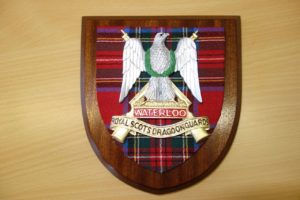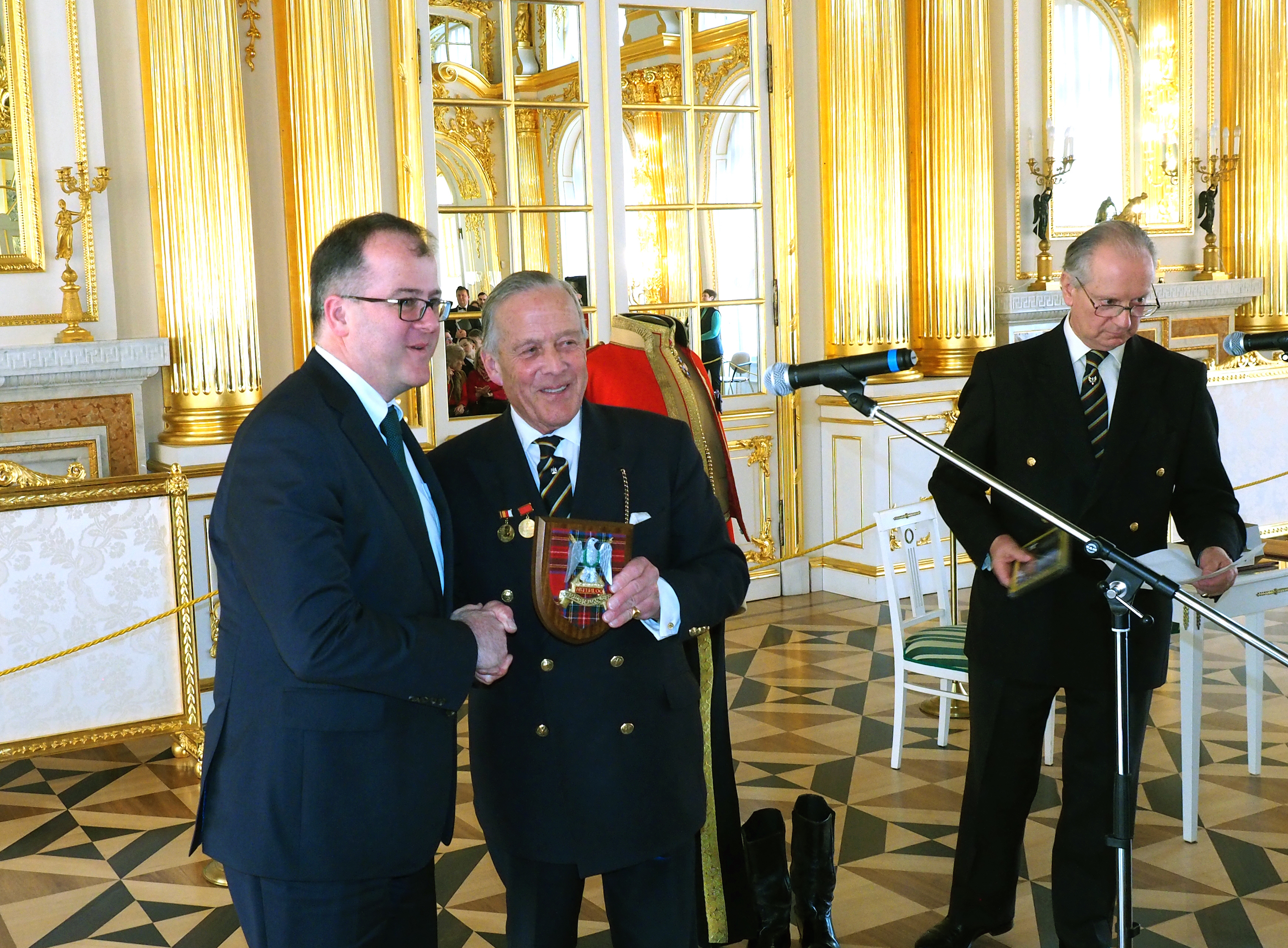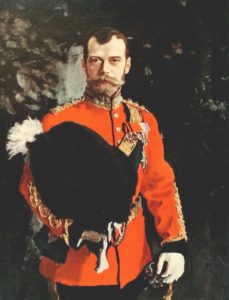19th April 2017
The Royal Scots Greys and Russia
We have been very fortunate to have had many wonderful events over the past few years commemorating many different periods of shared history between Russia and the UK. The latest event took place in early April when a delegation of retired officers from the Royal Scots Greys visited St Petersburg to present a replica dress uniform to the Tsarskoye Selo museum complex at Pushkin.
 Why the Royal Scots Greys and Russia? The Scots Greys have a long and interesting history with Russia. Britain and Russia were of course on different sides at Balaclava when the Scots Greys distinguished themselves. More recently the Royal Scots Greys met the Red Army in Germany just before the end of World War Two in May 1945. But perhaps the most striking symbol of the relationship with Russia is the fact that Tsar Nicholas II was Colonel-in-Chief of the Royal Scots Greys from 1894 until his death. Queen Victoria appointed him Colonel-in-Chief on the occasion of his wedding to Victoria’s granddaughter, Alexandra Feodorovna. Tsar Nicholas wore the uniform when he visited Queen Victoria at Balmoral in Scotland in 1896. The Scots Greys played a prominent role in the visit, escorting the Tsar when he disembarked at Leith and later when he arrived at Ballater railway station.
Why the Royal Scots Greys and Russia? The Scots Greys have a long and interesting history with Russia. Britain and Russia were of course on different sides at Balaclava when the Scots Greys distinguished themselves. More recently the Royal Scots Greys met the Red Army in Germany just before the end of World War Two in May 1945. But perhaps the most striking symbol of the relationship with Russia is the fact that Tsar Nicholas II was Colonel-in-Chief of the Royal Scots Greys from 1894 until his death. Queen Victoria appointed him Colonel-in-Chief on the occasion of his wedding to Victoria’s granddaughter, Alexandra Feodorovna. Tsar Nicholas wore the uniform when he visited Queen Victoria at Balmoral in Scotland in 1896. The Scots Greys played a prominent role in the visit, escorting the Tsar when he disembarked at Leith and later when he arrived at Ballater railway station.
The death of the Tsar in 1918 ended the relationship with the Royal Scots Greys until 1998 when the remains of the Tsar and other family members were interred at the Peter and Paul Fortress in St Petersburg. There were nine coffins containing Tsar Nicholas and his wife, Alexandra, three of the Tsar’s four daughters – Anastasia, Olga and Tatiana – and Alouzy Tropp, the Czar’s valet, Eugene Botkin, the royal physician, Ivan Kharitonov, a cook, and Anna Demidova, a lady-in-waiting. The remains of the Tsar’s other two children, Alexei and Maria have yet to join the family at their resting place in the Peter and Paul Fortress. President Yeltsin attended the service as did his Royal Highness Prince Michael of Kent. The then commanding officer of the Scots Greys (by then known as the Royal Scots Dragoon Guards), Colonel Andrew Phillips, and three colleagues, also flew into Russia the day before to participate. They took a prominent part in the service. An icon of Tsar Nicholas was presented to the Royal Scots Dragoon Guards. The icon has seen military action with the guards in Iraq and Afghanistan where it was placed inside a Challenger 2 tank (the magnificent Scots Greys were replaced by tanks many years ago!).
The Tsarskoye Selo museum complex already had the service uniform, including bearskin, belonging to Tsar Nicholas. Retired officers of the Royal Scots Greys decided to present the museum with a replica of a colonel’s dress uniform. The delegation was led by retired Brigadier Melville Jameson who is Lord Lieutenant for Perth and Kinross and was for many years the Director of the Royal Edinburgh Military Tattoo. The delegation also included Colonel Andrew Phillips who had attended the ceremony in 1998.


Tsarskoye Selo organised an official ceremony at Catherine’s Palace on 8 April. The Director of Tsarskoye Selo, Olga Taratynova, spoke warmly about the historical relationship with the Royal Scots Greys and how she hoped this visit and kind gift would lead to further collaborations with the Royal Scots Dragoon Guards Museum in Edinburgh. Brigadier Jameson and Colonel Phillips spoke about the importance of Russia and Tsar Nicholas II to the history of the regiment. I was delighted to host the delegation at the consulate and invited the Directors of Tsarskoye Selo, the State Hermitage and the State Naval Archives. The Deputy Director of the State Hermitage, who also holds the Russian title State Herald, had met Colonel Phillips in 1998 and spoke about his role organising the ceremony at the Peter and Paul Fortress.

The excellent Royal Scots Dragoon Guards Museum is located at Edinburgh Castle. There you will find a portrait of Tsar Nicholas in his uniform. Another interesting item on display is the Imperial Eagle standard captured from the French at the Battle of Waterloo in 1815. Well worth a visit: https://www.scotsdgmuseum.com/

Both the Tsarskoye Selo museum and the Royal Scots Dragoon Guards museum were very pleased with this visit and are confident that it will lead to further collaborations between two great museums. The memory of Tsar Nicholas II as Colonel-in-Chief of the Royal Scots Greys will live on in both Edinburgh and St Petersburg, and the Royal Scots Dragoon Guards will continue to call on their icon of Tsar Nicholas to bring them luck on their deployments.
Thank you for this most informative piece. Having recently watched one of Brian Cox’s programmes about Scots in Russia, I was fascinated but unclear on a number of points; now I understand.
Kind regards,